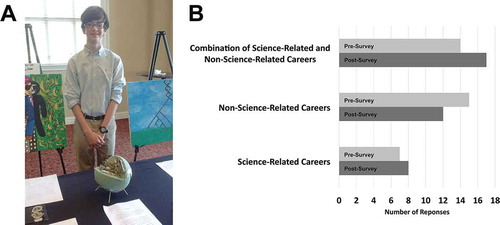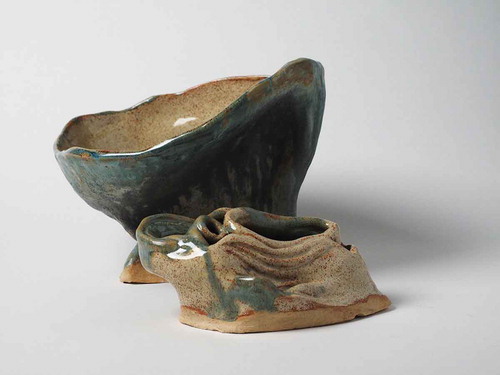Figures & data
Figure 1. The Cell Art Collaborative Program. (A) recycell by Noah Franks (miscellaneous recyclable materials). This human cell model made from recyclable materials is symbolic of a prominent world issue and how what we learn about cells can help us solve important societal problems. The recyclable composition of the piece relates to the problem of extra waste, which is emphasized in the continents of the earth (made out of aluminum foil) on the exterior of the human cell model. The U.S. is the #1 trash-producing country in the world, highlighting the need to find ways to efficiently manage and recycle/reuse waste. Cells have efficient ways to dispose of their waste or damaged components. One of these processes is autophagy, during which old or damaged cellular parts are broken down into their building blocks, which are employed to build new ones. Cells and their processes should be an example to us. Just as all the parts of a cell work together to keep the cell useful and healthy, we should work together to keep our planet clean. (B) The Cell Art Collaborative Program helped high school participants refine their career interests. During the first year of the program, students were asked to describe their future career preferences before (pre-survey, light grey bars) and after (post-survey, dark grey bars) participating in the program. Answers were coded and quantified (High Point University Institutional Review Board approval #201511-418)

Figure 2. Lipid biosynthesis and trafficking during autophagosome biogenesis by Casey Garr. The diagram was adapted from Goyal et al. [Citation3] and created using Autodesk 3ds Max. To create the protein models in the diagram, 3D data was collected from the Protein Data Bank. This data was utilized in the Visual Molecular Dynamics program to create 3D models, which were then transferred to and rendered in Autodesk 3ds Max. Due to the unavailability of complete 3D data, artistic license was used in the rendering of some proteins (Atg9 and Atg27)
![Figure 2. Lipid biosynthesis and trafficking during autophagosome biogenesis by Casey Garr. The diagram was adapted from Goyal et al. [Citation3] and created using Autodesk 3ds Max. To create the protein models in the diagram, 3D data was collected from the Protein Data Bank. This data was utilized in the Visual Molecular Dynamics program to create 3D models, which were then transferred to and rendered in Autodesk 3ds Max. Due to the unavailability of complete 3D data, artistic license was used in the rendering of some proteins (Atg9 and Atg27)](/cms/asset/593bb69d-a45a-4c6a-867b-4562a2143d74/kaup_a_1769972_f0002_c.jpg)
Figure 3. AP-3 Pathway: A sculpture by Candyce Sturgeon (clay). Inspired by Atg27 being an AP-3 cargo, Candyce set out to use clay to represent the donor and target organelles of the AP-3 pathway, the late Golgi and the vacuolar membrane

